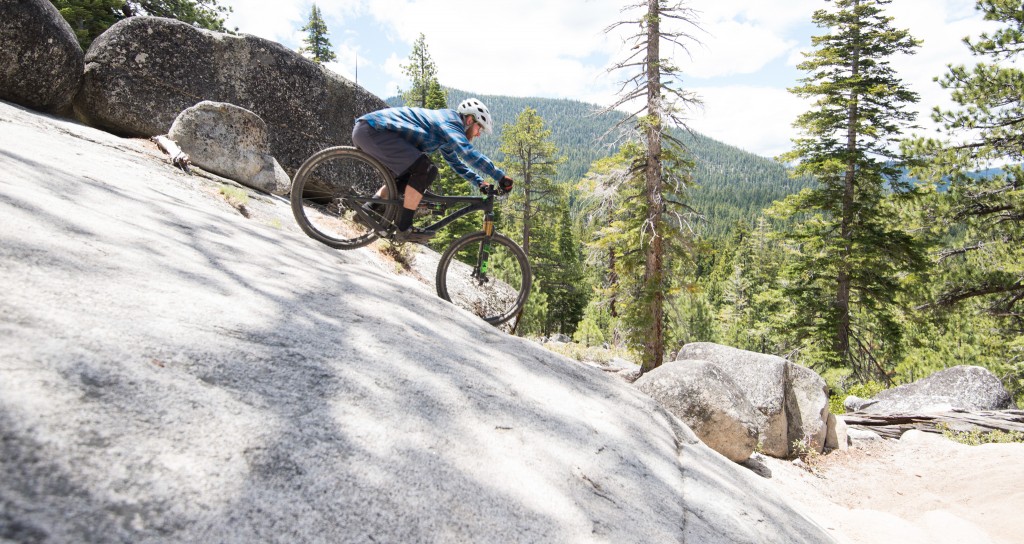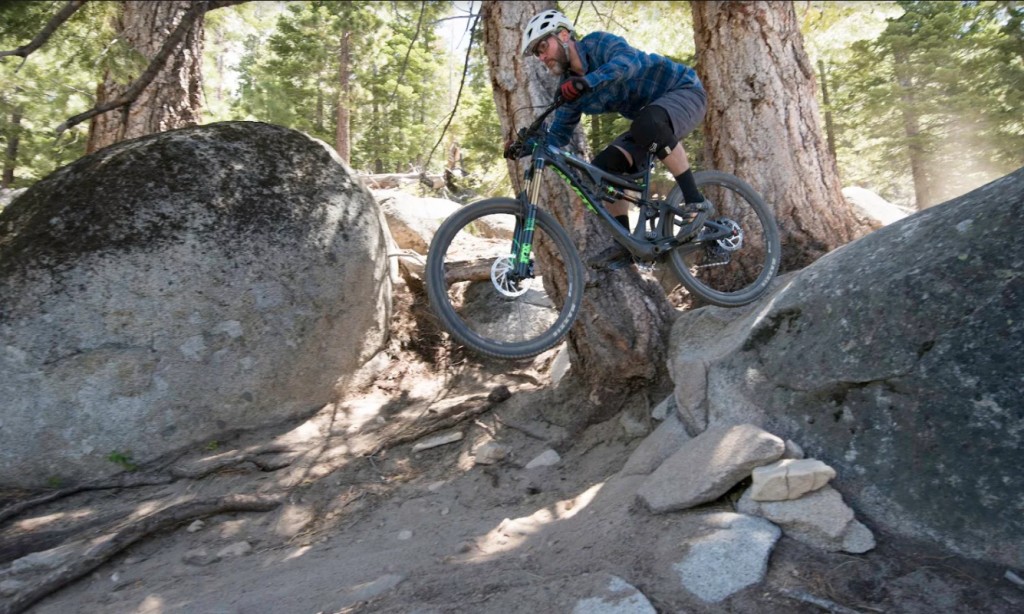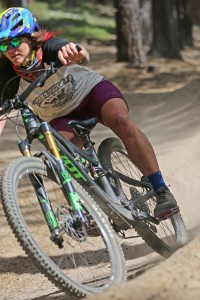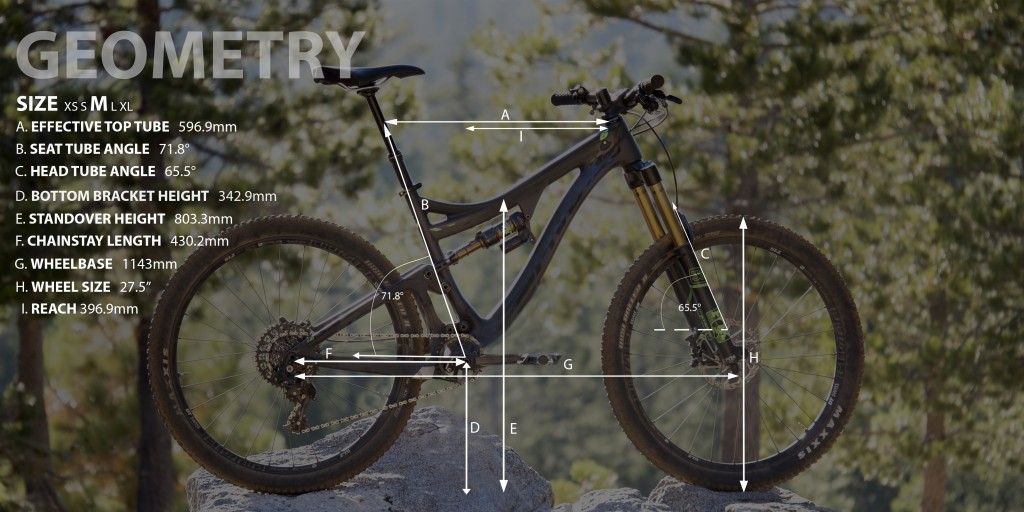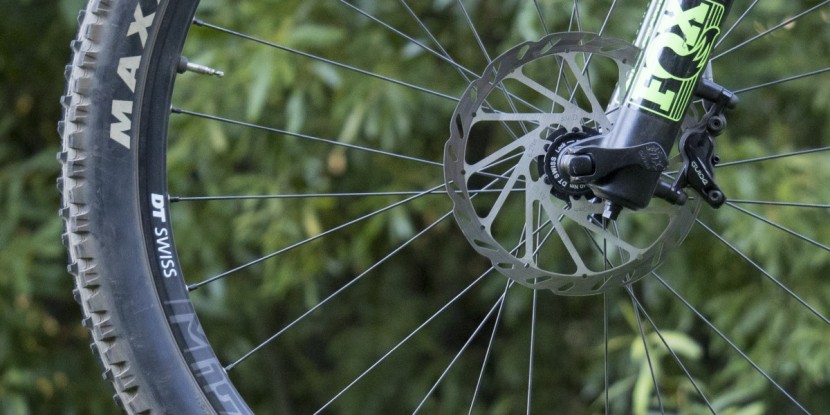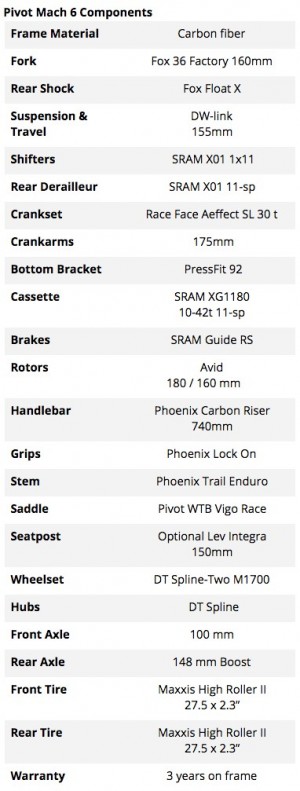Pivot Mach 6 X01 2016 Review
Our Verdict
Our Analysis and Test Results
We tested the Pivot against the descent slaying 2016 Santa Cruz Nomad, well-rounded 2016 Yeti SB5.5c, playful 2016 Ibis Mojo HD3, and 2016 Specialized Enduro, using both long-term riding and intensive racing processes. A team of four expert mountain bikers took them out on hundreds of trail miles and raced them against one another to figure out which is the very best. Read more about the Pivot below.
Interestingly, we had a very favorable view of the Pivot early on in the test. Despite noting the overly cramped cockpit at the outset, we had a blast, declaring it a particularly fun, aggressive descender. Our lead tester came down from his inaugural ride saying, “By the time I got to the bottom I had the biggest smile on my face I couldn't stand myself.” He thought it would win the test. Then things shifted. Putting more time in on the other bikes helped surface the Pivot's relative weaknesses. The Pivot's fork felt like it was diving on our two heaviest, most aggressive riders, mostly because the tight cockpit made it hard to unweight. Continually adjusting body positions over the bike while screaming downhill got old real fast.
Downhill
The Mach 6 ranked lowest in the downhill tests. The Santa Cruz Nomad and Yeti SB5.5c topped this category. The Pivot's rear suspension was plush and well-liked by the testers. It was only when we had enough time in on the bike to isolate the out-of-the-box fork issues and get tired of adjusting to the fit that confidence levels waned to the point of flat out distrust. We rated the Pivot Mach 6 at a 5 of 10 as it is still an adequate, borderline fun, descender.
Speed
During our benchmark time trials, we raced the Mach 6 against our four other top enduro test bikes on our carefully selected downhill enduro course, The Scorpion. We averaged the resulting times to find the relative performance advantages below.
The Mach 6 had the slowest average time in our downhill benchmarking tests. Our two fastest bikes, the Santa Cruz Nomad and the Yeti SB5.5c kicked it at The Scorpion's tail end for an average of 3.3 and 5.8 seconds, respectively before the Pivot showed up.
Factors affecting the Pivot's downhill speed, aside from the fit and front fork, include a squirrelly front tire, overly narrow rims, and pedaling problems. The Pivot lost some pedal power into the rear suspension when the compression was opened up for the descent. That, combined with the rider's suboptimal pedaling position over the rear tire made the bike slightly sluggish despite a pleasant pedaling feel.
Confidence
Sitting on the rear wheel is not a power position, but that's where we found ourselves when pointing downhill. The Pivot created a confidence deficit. If riding the Yeti SB5.5c can feel like you're sneaking Dad's ride out for a spin, this one will make you feel like Dad, stealing your middle schooler's bike. We found the cockpit awkward. With a measured 369.9 mm reach (the shortest in the test by 46mm), it had us constantly battling for position to maintain balance and stay far enough back to avoid going over the bars.
Complicating this issue for three of our riders was the whole fork thing. The Fox 36 is a nice fork, and we appreciated its performance on the Yeti SB5.5c's boosted front end, but its performance on the Pivot Mach 6 terrified three of our riders (5'10", 170 lbs, 5'9', 150 lbs, and 5'7, 140 lbs). With the short reach pushing our weight further over the bars the fork tended to ride soft, diving under our most aggressive riders. Our other tester didn't find the fork diving but shared the challenge of struggling to maintain optimal body position on the descent, giving them that all-over-the-bike feel.
Three of us went down on the Pivot. Hard. The only other bike that crashed in the test was the Specialized Enduro Expert. And it only took down one of us.
Interestingly, one of our all-mountain oriented testers (5'10", 150 lb with beefier legs and a lean torso) felt comfortable in the medium cockpit. He likes the more upright position that the short reach enforced, didn't mind getting back a touch further than normal, and found no fault with the fork setup. He did, however, feel that the Pivot was less stable on steep and technical terrain that the Yeti SB5.5c or the Santa Cruz Nomad.
While our fit and fork issues varied, we all came back together to agree: this is a creaky bike. The headset started complaining whenever we torqued the handlebars early on and, as one tester put it: “The whole suspension is loud. There's a lot of clanging.” The pivots loosened up earlier than the other bikes. Sure you can fix this all at a bike shop, but having such issues so quickly suggests a frequent need to do so.
Handling
The Pivot has good responsive steering, and it picks its way through obstacles nicely at slow speeds, but, when you ramp up the RPMs, and the angle of descent, the bike's steering isn't as direct. That vertically great rear suspension will keep you from getting tossed up over the bars, but it does deflect laterally on big hits, as do the flexy wheels. This bounces the bike around in the rock gardens, making it difficult to stay on line. Add to that the challenge of straight-arming it off the back while keeping enough pressure on the front tire to keep from drifting, and this is a challenging downhill ride. And again, if we weight the factory fork setup too much it dives — steepening up the head tube angle and putting pressure on that sketchy front tire, which then swerves around like a dog-chased squirrel. These factors combine to produce a less than stable sensation at speed.
If you can manage to weight both tires correctly the handling is pleasant at moderate speeds on moderate terrain, but we just can't get over the fit. As our lead tester puts it, “even though it handles great, it just doesn't feel right that I should have the saddle in my stomach the entire time I'm riding down the hill.”
Suspension and Traction
The Fox 36 is a respected fork, and it performed well on the boosted Yeti. However, the bike's short reach measured at 397mm) had our body weight hovering over the Mach 6's front end constantly. The spec'd fork set up — one small, blue volume spacer — couldn't take the pressure, equaling a terribly performing fork out-of-the-box. It tended to wallow, in its suspension off the bat, giving us too good of a view over the bars. Then it would dive out on our more aggressive riders. Upping the PSI and increasing compression dampening helped, but the fork still didn't perform optimally.
The small Blue volume spacer, takes up 7.6ccs, reducing the amount of pressure required to compress the air in the fork enough to keep it from bottoming out. This makes the fork more progressive, letting it respond to smaller bumps without busting beyond the travel on the big ones. Conventional wisdom holds that if you're a heavier or more aggressive rider, you benefit from more or larger volume spacers. After testing, we put in two blue spacers and increased the low-speed compression setting to see if we could get it to stiffen up. It did. Our three testers who experienced dive in the fork could have used another blue spacer or perhaps just one orange to bump it up to 10.8 ccs.
Luckily the rear end made up for it. The rear shock's ability to take a hit kept us from getting bucked up to the bars in all but the most extreme of circumstances. And it's a good thing, because, once you're up there you might as well just tuck and roll because there's nowhere to go but up and over. “I felt like I had to wheelie the bike everywhere, climbing and downhill, cause the rear end felt great,” said our lead tester. In contrast, the Ibis Mojo HD3 sports the best fork in the test, a boost spaced RockShox Pike rising off of barely plus sized 2.5 tires. But the Ibis's backend is chattery in the small hits and can buck like a bull on the big ones. The other bikes had more balanced suspension setups - either all great (Santa Cruz), all darn good (Yeti), or all begrudgingly adequate (Specialized).
While the early stroke of the Pivot's rear suspension feels similar to that of the punchy Ibis Mojo HD3, it opens up to soak up the rough stuff and helped the back tire maintain traction throughout the descent. Of course, it doesn't touch the plush feel of the Santa Cruz Nomad's suspension, but nothing in the test did.
However, while our biggest, fastest, smashiest rider (5'10", 170 lbs) loved the vertical action of the Pivots back triangle, he did feel some lateral deflection in the rear end, despite the 12 x 148 mm boost rear spacing. (We all felt some flex in the wheels.) He liked the resulting whippy feel out of corners but had to shift his weight constantly over the backend to accommodate for the flex. Two other riders (5'9", 5'7") also felt the need to constantly adjust over the rear, but attributed it to the tight fit and need to find the proper balance point.
It's worth noting that two of our testers threw the chain on the Pivot, one of them wrapping it around the pedal end of a fully extended crank pointing dead ahead. Both instances occurred at the rather aggressively angled intersection of a long rock slab and the dirt. This wasn't an issue with any of the other bikes (only the Santa Cruz and Specialized have chain guides).
Climbing
The Pivot puts you in that classic upright climbing position that just feels efficient, as long as you fit the bike. But the extra cramped quarters made it hard for many of us to get our weight off the front tire enough to lift it over obstacles or the back wheel enough to roll it up afterward. And, somehow, you have to be over that back end the whole time as well, this time to keep your rear wheel from spinning out on those technical climbs. These factors negate the initial pleasant pedaling feel, slowing the Pivot Mach 6's uphill roll. As a result, the bike ties the Ibis Mojo HD3 in last place for climbing. There is a jump up to the next two bikes; the Santa Cruz Nomad with and the Specialized Enduro to reflect a similar jump in timed gained on the technical climb and in comfort. The Yeti SB5.5c wins the category handily.
- -Speed--
The Ibis only beat out the Pivot by an average of 0.5 seconds, leaving the two DW-link pedaling platforms in the test a bit behind the other bikes. The Yeti SB5.5c was 6.4 seconds faster on the 2:14 min:sec course on average. We blame the Pivot's tricky back tire, which tends to skid out on the climbs, and the bike's sluggish acceleration, for slow times.
Pedaling
Despite a pleasant pedaling feel, the Pivot's acceleration seemed sluggish to our testers in both trail and open compression settings, giving the bike a heavy feel (even though we weighed it as the second lightest bike in the test at 28 lbs). When the compression damper is in firm mode, the suspension nearly locks out, improving the pedaling sensation. But this only works on smooth trails of course.
The Pivot is one of the slowest accelerators of the 27.5" bikes in the test, along with the Santa Cruz Nomad. Only the Yeti SB5.5c is more sluggish. However, once you get the Santa Cruz and Yeti to speed, those big tires want to keep rolling. That is not true of the Pivot, which requires constant spinning to stay at speed. Coming out of a corner or up and over an obstacle in the wrong gear is a recipe for grinding.
As always, fit matters. Three of our riders felt the pedaling was off because their legs were in an unfamiliar location in relation to their hips, reducing pedaling efficiency. The Pivot's measured reach is the shortest in the test at 396.9mm, and its seat tube angle is the slackest at 72.3°. This geometry did not set our testers up comfortably.- -Handling--
The uncomfortable fit made negotiating these challenges on a climb extra challenging for all but one of our testers. We found knees knocking into chests or forcing elbows far enough out to tag trees. “On the uphill, when pedaling out of the saddle I felt like I was running past the bike,” said one tester. The short reach had his hands level with his waist and back under his shoulders. Being so far forward when initially placing the bike on a technical element of the trail — say a stair — left him no room to maneuver for recovery if the placement wasn't perfect.
Our 5'10" tester who didn't mind the Pivot's fit as much felt that its handling is very precise. It did take him more work and body balance to get over the rocks than it did on the Santa Cruz Nomad — which plows through whatever line you happen to be on regardless — but it was a more controlled action.- -Suspension and Traction--
Traction was tricky. The rear wheel kept wanting to spin out on the climb, especially when climbing up and over the dust-covered granite stairs. One of our testers figured out that he had to shift his weight back to keep the back tire from spinning. Another kept spinning the tire, and a third found the bike well balanced and never noticed a problem. We think this issue was more tire tread and weight distribution than suspension.
Cornering
In the short, quick turns, both the Pivot and Ibis performed similarly, snapping out of the corners with aplomb. On wider turns, however, the Pivot railed, but its narrow rims rounded the front tire, a Maxxis High Roller II. The combination required an aggressive toss into the turns to get over to the side knobs. It often washed out for a moment before hooking back up on its cornering knobs. This was exacerbated by the need to move forward and weight the finicky fork to prepare for the corner. These were predictable, adjustable problems that were a quick fix.
While neither the Ibis nor the Pivot offered a confidence-inspiring ride on rougher corners, the Pivot's plush rear end performed slightly better. It was still necessary for several of the testers to constantly adjust their weight laterally over the Pivot — instead of just fore and aft as is the case on most bikes — to keep it together.
Race Factor
Last place in both descending and climbing, the Pivot is the overall benchmark we measure the faster bikes against. The winning Yeti has a combined advantage of 12.2 seconds on our up and downhill enduro race courses, The Soul Grinder and The Scorpion.
Fun Factor
This bike nearly combines the quick cornering of the Ibis Mojo HD3 with the stability and badassery of the Santa Cruz Nomad. It hints at off-the-charts fun factor. Sadly it falls short, like an awkward knuckle-landing on a jump, neither here nor there. And it was a little more work to pop the Pivot off jumps than the Santa Cruz Nomad or Ibis Mojo HD3, but it's suspension felt good on the landing, as long as you didn't find yourself over the front. If you keep your balance, it's an awesome jumper. But it's easy to lose, making the Pivot somewhat unpredictable in the air.
The trick fork, old-school rims, skidding tires, flexy rear end, and ridiculous fit pushed the Pivot towards the Type II end of the fun spectrum. It's still a good time, but you're often too gripped to fully give into the glory of riding. We gave it a 4 of 10. The Specialized came it right above with an average score, 5. The Ibis came in at a 7 for its playful nature while the Santa Cruz Nomad comes it at a 10 for most fun, friendliest descender.
Build
We had some serious problems with the Mach 6's build. Read on for the reasoning.
Cockpit and Fit — With the shortest (397mm) reach and the slackest seat tube angle (71.8°) in the test, the Pivot is uncomfortable. It doesn't leave us with enough room to move around and made a balance point hard to find for the climbs and descents. It's just an odd setup. Pay close attention to the reach measurement and seat tube angles on this bike.
Frame and Suspension — That odd fit kept us over the front end and the160mm Fox 36 Factory fork. Spec'd with one blue volume spacer, it had a hard time dealing with all the extra attention from our most aggressive riders. Though the rear suspension felt great vertically, there was a lot of lateral movement from the wheels and some from the rear triangle. The Fox Float X rear shock's rebound adjustment is ridiculously tucked into the frame and very hard to access on the trail. There's also no mount for a water bottle. The pivots and rear axle also rattled loose by the end of testing. A quick fix, but not one that was needed on the other bikes.
Wheels and Tires — The 582 x 22.5 rims on the DT Swiss Spline-TWO M1700 wheels were just too narrow. DT Swiss lists the set as primarily all-mountain, but these are not enduro wheels. Ballooning the tires into a rounded shape, they kept the tread from optimizing traction and exaggerated the gap between the center and cornering knobs. Wider rims that allowed the tire to spread out and square-off would make it much more enduro-ready machine.
Groupset — The RS brake levers are a step down from the RSC (spec'd on the Yeti, the Santa Cruz, and the Ibis) and the rear brakes are underpowered with a 160mm rotor. Speaking of rotors, the Pivot is the only bike to use Avids, a step down from the SRAM Centerline. These made a disconcerting, watery sound. There's also no chain guide, allowing us to wrap the chain around the crank twice.
Handlebars, Seat and Seat post — The Pivot is the only bike in the test that didn't come spec'd with a dropper post. The KS Lev Integra Dropper is considered an upgrade, to the tune of $376.99. We bought it, mostly because we couldn't be bothered to ride it without one, just like most folks these days. But the housing for the dropper post cable routing is unanchored, making for a loud ride.
Best Applications
We just wouldn't buy this bike if any other bike in the test was available. That being said, if you can get the fit right for you, the Pivot would be a good all-around bike for moderately technical single track in rolling foothill territory with no huge climbs or long/demanding rocky stretches. You'd be particularly stoked if you like cornering and you live near a lot of smooth trails.
Value
The 2016 Pivot Mach 6 is the least expensive complete bike in the test at $5,199.00. If you include the $376.99 upgrade to a KS Lev dropper post, you're up to $5,575.99. That leaves you with about a $424 jump to the $6,000 Specialized Enduro Expert and a $623 to the Ibis Mojo HD3. We think the extra money is worth both bikes' more balanced frames and seemingly solid construction.
It's a bigger jump to the Santa Cruz Nomad for $6,999 or the Yeti SB5.5c for $6,999. These bikes have both solid frames and well-chosen componentry, so you're getting your money's worth. If you can afford to step up to the Yeti or the Nomad (or find them on sale), we recommend it. If you're investing over $5,000 in a bike, makes sure you spend enough to get what you're looking for. We just don't think this version of the Pivot Mach 6 is quite there.
Conclusion
The Pivot is loved and loathed alternatively as it can rip downhill and screams through corners but has an awkward fit that makes it almost impossible to balance over, shaking confidence. There's certainly potential here — and we wanted to hold on to our early admiration — but the tricky fork, rattling pivots, flexy wheels and slightly flexy rear triangle keep it from reaching reality.





